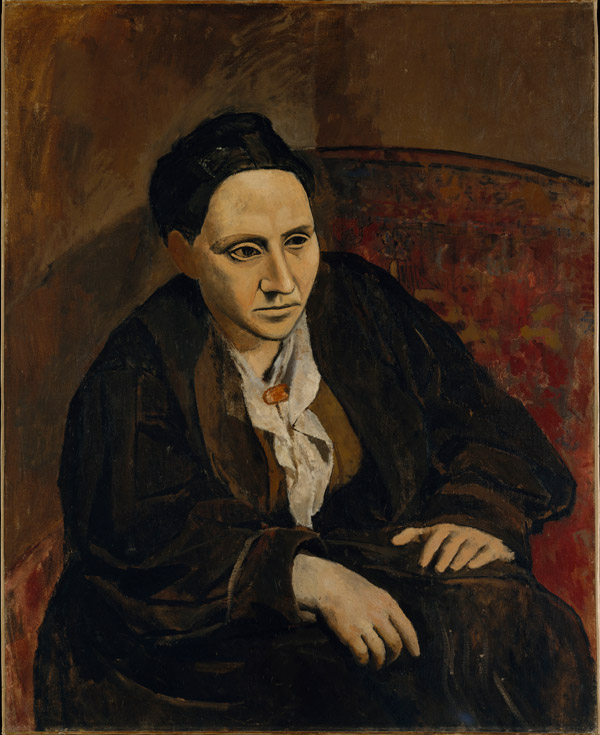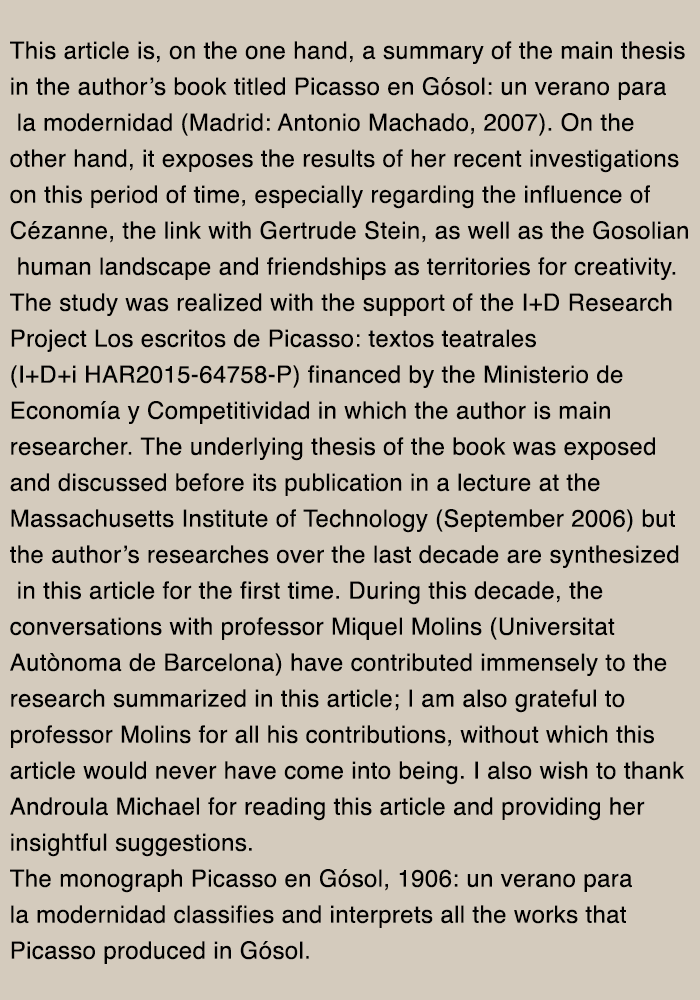Three simultaneous reasons behind Picasso’s rebirth:
1906 was the year when Picasso abandoned nineteenth-century procedures still present in his Blue and Rose periods and embarked on a journey towards his peculiar form of modern art. It was in the Portrait of Gertrude Stein that he experimented with this transformation, as his then very close friend explains when describing his “long struggle” at that time.[1]
This “long struggle” took place during winter, spring and summer of 1906, in an unprecedented number of posing sessions[2] which ended in May with the deletion of Stein’s face, and it continued during Picasso and Fernande’s trip to Gósol, a small Catalan town on the southern slopes of the Pyrenees. Picasso’s return to Paris towards the end of July was, rather than the end of a journey, the confirmation of a rebirth for the artist who, by then, had completely embraced his peculiar modernity. The swift and conclusive completion of Stein’s portrait was the first event of this renaissance.
The aim of this article is to propose three simultaneous reasons behind Picasso’s rebirth: his stay in Gósol, his facing and tackling of Cézanne’s doubts for the first time and the creative power friendship had on him. These three intertwined reasons will be presented in three different sections and spheres of research.
[1] See Gertrude Stein, The Autobiography of Alice B. Toklas, in Writings, Vol. I: 1903–1932 (New York: The Library of America, 1998), 653–913, the text in 713. See also Gertrude Stein, Picasso, in Writings, Vol. II: 1932–1946 (New York: The Library of America, 1998), 497–533, see especially 502 and 509–513. When reading these texts, the first written in 1932 and the second in 1938, one has to bear in mind that during that time the friendship between Gertrude Stein and Picasso had cooled down and she was showing a new friendship for Bernard Faÿ, that the writer was drifting towards Pétainism, and that the abovementioned texts have, in my opinion, a certain tone that seeks to recover something lost. On Stein’s fascist drift see especially Barbara Will’s devastating work: Unlikely Collaboration. Gertrude Stein, Bernard Faÿ and the Vichy Dilemma (New York: Columbia University Press, 2012). See also thefollowing works, more condescending than Will’s: Edward M. Burns and Ulla E. Dido, The letters of Gertrude Stein and Thornton Wilder (New Haven and London: Yale University Press, 1996), 405; Luci Daniel, Gertrude Stein (London: Reaktion Books, 2009); Laurence Madelaine, Gertrude Stein, Pablo Picasso. Correspondance (Paris: Gallimard, 2005), 349–351; Nadine Satiat, Gertrude Stein (Paris: Flammarion, 2010), 849–976; Diana Souhami, Gertrude & Alice (London – New York: I. B. Tauris, 1991, reprinted in 2010), 221–40. For an interpretation of the Portrait of Gertrude Stein discussing the sexual identity in the relationship between the painter and the model see Robert Lubar, “Unmasking Pablo’s Gertrude: Queer Desire and the Subject of Portraiture,” The Art Bulletin 79 (1997): 57–84. For the friendship between Picasso and Gertrude see Hélène Klein, “Gertrude Stein and Pablo Picasso: In their Own Words”, in the catalogue The Steins Collect. Matisse, Picasso, and the Parisian Avant-Garde. (New Haven and London: San Francisco Museum of Modern Art in Association with Yale University Press, 2011) 243–57. For an exhaustive and hagiographic approach to Stein’s biography see Wanda A. Corn and Tirza True Latimer, Seeing Gertrude Stein. Five Stories. (San Francisco: Contemporary Jewish Museum; Washington: National Portrait Gallery (Smithsonian Institution); Berkeley, Los Angeles, London: UC Press, 2011).
[2] Gertrude Stein stipulates about ninety sessions. As she wrote, “In 1906 Picasso worked on my portrait during the whole winter” (Stein, Picasso, 512). See John Richardson (with the collaboration of Marilyn McCully), A life of Picasso. Vol. I: 1881-1906 (New York: Random House, 1992), chapter 26, 404; Scholarship, however, considers this amount to be an exaggeration. See Gary Tinterow and Susan Alyson Stein (Eds) Catalogue, Picasso in the Metropolitan Museum of Art (New Haven and London, 2010), 103.






 Summary
Summary